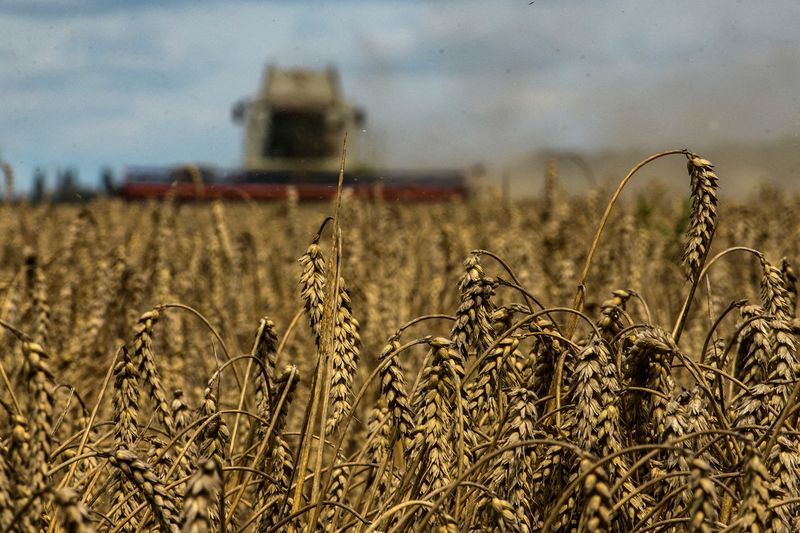By Karl Plume
(Reuters) - A patchwork of fixes and increased crop plantings around the world to counter the impact of war in Ukraine on global grain supplies are not enough to ward off further risks of disruption.
Extensive damage to Ukraine's farm sector and uncertainty that the UN's grain export corridor deal will be renewed this month suggest food prices may remain elevated, increasing the potential of hunger if other problems arise, agriculture experts warn.
Meanwhile, adverse weather, including a historic drought in No. 3 corn exporter Argentina, highlights the risks of increasingly severe weather around the world for food supplies.
A year after Russia's war on major grains producer Ukraine sent global crop values to decade highs on fears of shortages, prices of key crops have reverted back to pre-war levels, with benchmark corn futures down 10% and wheat futures more than 20% lower than the days before the invasion.
"The world has had some time to patch some holes," said Dan Basse, president of AgResource Co in Chicago, citing larger-than-anticipated Russian wheat exports and the grain export corridor deal that allowed some 3 million tonnes of grain per month to be exported from Ukraine's Black Sea ports.
"If we don't have another supply shock somewhere, the world can get by on the diminishment of Ukrainian grain. But it's tenuous. Things have to go right," he said.
Importing nations avoided a worst-case scenario as a record Russian wheat crop that was exempted from sanctions and bumper harvests in Australia and Canada helped offset sharply reduced Ukrainian wheat shipments. A surge in Brazilian corn production, meanwhile, blunted the impact of lower supplies from Ukraine and a weaker-than-expected harvest in the United States, the world's top exporter of the feed grain.
The UN food agency's world price index in February was down 19% from a record hit last March.
"Luck has played some role in events ... the combination of good weather (in some breadbasket areas) and strong producer supply response has kept market prices from rebounding back to the high levels of early 2022," said Joseph Glauber, senior research fellow at the International Food Policy Research Institute.
But prices are likely to remain volatile this year, particularly during planting and key crop development phases, as global grain stocks remain tighter than normal.
"With production in Ukraine assumed to be even smaller in the coming season, other exporters will again be required to step to the plate, adding further impetus to cropping weather over the next year or so," said International Grains Council (IGC) economist Alexander Karavaytsev.
Global wheat stocks are projected to thin to just over a three-month supply by the end of the 2022/23 season, the tightest in eight years, according to U.S. Department of Agriculture (USDA) data. Corn stocks were seen at an 81-day supply, down 22% from a recent supply peak six years ago.
OTHER BREADBASKETS
Global grain merchants and fertilizer makers warned that the world would need multiple good harvests to rebuild supplies.
"The world is looking to the other breadbaskets ... to make up for some of this gap," said Ken Seitz, CEO of the world's biggest fertilizer producer, Nutrien Ltd, in an interview.
Although Brazil is expected to harvest a record 125 million-tonne corn crop this year, production in No. 3 exporter Argentina is seen dropping to the lowest level in at least five years after the worst drought in 60 years, USDA data showed.
Rising interest rates and a strong U.S. dollar, which makes dollar-denominated commodities more expensive for buyers holding other currencies, have heightened the risks for importing countries, IGC's Karavaytsev said.
The Black Sea grain export initiative will be key to determining global grain supplies going forward, analysts said.
A renewal would allow exports to flow in the near term while continued access to global markets may encourage more Ukrainian growers to plant this spring despite the ongoing war, they said.
But high input costs, farm equipment losses and safety concerns suggest seedings will be even smaller than last year.

Ukraine recaptured farmer Borys Kalynovskyi's fields in the northeastern Kharkiv region from Russian occupation in autumn, but much of his land was heavily mined.
"It's very, very dangerous for workers right now to try even to do something in the fields," he said.